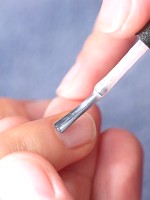
|
Fungal Guide
.ca
Fungal Infections Treatment Information.
|

|
| Fungal Guide | About Us | Dermatology Glossary | Skin Care Network | Fungal Guide Site Map |

Put Your Best Foot (or Hand) Forward
Get healthy nails
Nail fungus is an infection that can be awfully embarrassing when you want to put your best foot -- or hand -- forward. But no need to cringe when you want to shake hands with someone or you have to avoid your favorite sport because of pain.
Nail fungus is treatable. A complete description of treatments can be found at Fungal Guide .ca You can take steps to prevent it happening in the first place.
I just can't put my finger on it ...
- Nail hardeners may contain damaging products to nails.
- Nail polish waterproofs nails and causes the skin underneath to stay wet longer, which makes them more susceptible to infection.
- Lighter shades of nail polish help the light get through the nail.
- Don't try to repair nail enamel every day.
- Keep an eye out for signs of nail infection, such as redness, pain or pus.
- It's not a good idea to apply artificial nails over your own because the chemicals and glue in the products are absorbed through the damaged nail and nail bed. Artificial nails have been known to contribute to the development of fungal infection in fingernails.
Walk away with these tips ...
Since you will have logged more than 115,000 miles on foot throughout your lifetime, it's a good idea to care for your feet.
- Wash and dry your feet daily, especially between the toes where fungus can get in
- Don't soak your feet in hot water, always use warm.
- Use a medicated antifungal powder if your feet will be sweating a lot during active activities.
- Do moisturize your feet regularly to prevent cracking skin that can let fungus enter. But don't put lotion between the toes since this is the primary spot for fungus to breed.
Even if you take daily showers and scrub the bathroom with disinfectant, you can still get this nasty infection. Why? Because the microscopic fungus that causes the infection thrives in warm, moist areas in the environment - locker rooms, showers, nail salons - even your garden. And you may be predisposed to infection from certain medical or occupational risk factors that make it more likely for you to get nail fungus. These include:
- a history of athlete's foot
- having nail fungus before
- being injured, such as a stubbed toe or lacerated finger
- time you spend at swimming pools, spas and locker rooms
- wearing acrylic nails
- perspiring feet
- wearing tight shores or hosiery
- being age 40 or older
- having it in your family
- having medical conditions such as diabetes, circulatory problems, or immune disorders such as AIDS, or your immune system is compromised
Remember, without treatment, nail fungus will continue to infect your nail. Although it may take a while, untreated nail fungus will usually get worse. So check with your doctor to learn about your treatment options.
For more information about all kinds of fungal infections, click on www.FungalGuide.ca
Back to Fungal Infections Articles Index